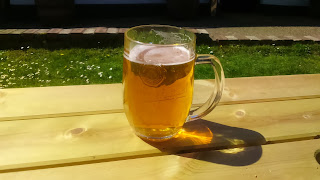 My last post, about drinking at home, was an attempt to inject a sense of realism into the argument that enjoying a few beers in the comfort of one’s own house, is one of the main reasons that pubs are dying on their feet.
My last post, about drinking at home, was an attempt to inject a sense of realism into the argument that enjoying a few beers in the comfort of one’s own house, is one of the main reasons that pubs are dying on their feet.I don’t wish to go over the ground already covered in that article but instead, as I sit here in front of my computer bashing away at the keys, I want to tell you about the beer I am drinking, and really enjoying. It is a beer which has become my beer of choice for drinking at home, and it may surprise you to learn that it is a well known brand, and one which is becoming much more widely available.
The beer I am talking about is Pilsner Urquell, and it is the world’s first golden lager. It is brewed in the Czech Republic, in the Bohemian city of Plzeň (Pilsen). In Czech, the company and its beer are known as Plzeňský Prazdroj, but the brand is better known by the German name of Pilsner Urquell. The words "Prazdroj" and "Urquell" both mean “original source" in their respective languages, and with a history dating back to 1842 Pilsner Urquell really can justify its claim to be as the “Original Pilsner”.
 |
| Pilsner Urquell Brewery |
They commissioned a Bavarian brewer called Josef Groll, to develop a better beer for them, using the bottom-fermenting techniques which were common across the border in neighbouring Bavaria. Groll set to work and the beer he came up with was set to revolutionise not just Plzeň and Bohemia, but the whole world. The new beer was first served at markets held to celebrate the feast of Saint Martin, on 11th November 1842. The beer’s eye catching golden colour and clarity was immediately successful, and became the inspiration for more than two-thirds of the beer produced in the world today. In homage to the original, most of these beers use the names pils, pilsner or pilsener.

The beer has an ABV of just 4.4%, but it drinks like one of a much higher strength. A peppery hop bitterness, derived from the prize Saaz hops, is to the fore, but lying underneath is the most delectable toffee maltiness. As well as imparting bags of flavour the malt gives body to the beer. With this sort of combination it really is one of the most satisfying and thirst –quenching beers around.
The prominent maltiness is a direct result of the triple-decoction mashing regime still practiced at Pilsner Urquell. Most continental breweries still employing the decoction mashing system, practice the less intense double-decoction version, and many have now abandoned decoction mashing altogether, in favour of the more energy efficient (but less intense, flavour-wise) infusion mash – as traditionally practiced in the British Isles.
I
 won’t go into the technicalities of these different systems, but essentially decoction mashing evolved to cope with continental strains of barley and their associated high levels of nitrogen (essentially protein). If used with the simpler infusion mash, the nitrogen would carry over into the finished beer, resulting in unacceptable levels of haze. Pilsner Urquell claim they are one of the few breweries still using this system, and as if this was not enough they still use wort kettles constructed out of traditional copper.
won’t go into the technicalities of these different systems, but essentially decoction mashing evolved to cope with continental strains of barley and their associated high levels of nitrogen (essentially protein). If used with the simpler infusion mash, the nitrogen would carry over into the finished beer, resulting in unacceptable levels of haze. Pilsner Urquell claim they are one of the few breweries still using this system, and as if this was not enough they still use wort kettles constructed out of traditional copper.Today, for the moment at least, Pilsner Urquell is owned by global giant SAB Miller, and although the old system of fermentation in open-top wooden vats followed by a long maturation period deep underground in huge, pitch-lined wooden barrels, has long been abandoned in favour of more modern methods, it is still a first class pint.
Most of the major supermarkets run a promotion on Pilsner Urquell from time to time, meaning it is normally possible to pick up a 500ml bottle for around £1.50. This is a real bargain for such an excellent beer, but I hinted above that SAB Miller might not be the owners of the brewery and the brand for much longer.
 |
| Yours truly enjoying a beer with Brewmaster Václav Berka |
It really is a case then of watch this space, and keep your fingers crossed that whoever ends up as new owner of Pilsner Urquell leaves well alone, so that beer lovers across the globe can continue to enjoy this pioneering, world classic beer in its present form.























